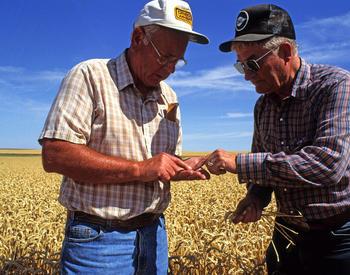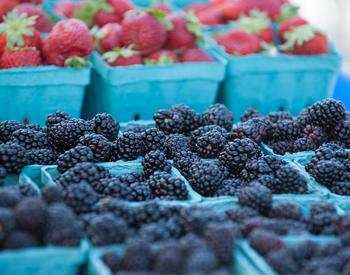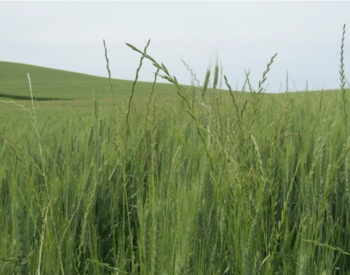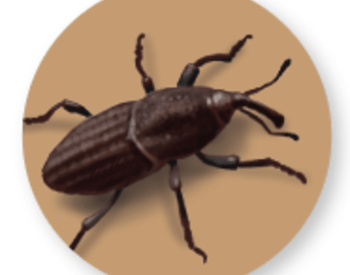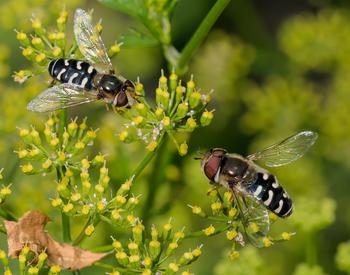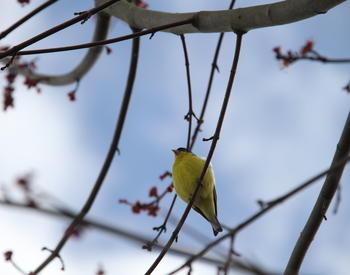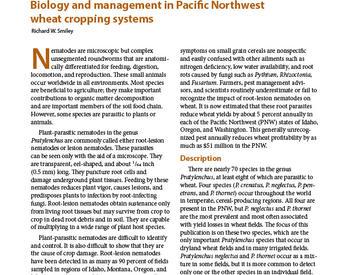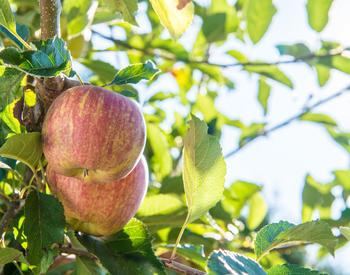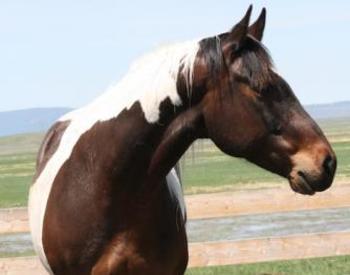Damage and host plants
The cereal leaf beetle has caused crop damage in Malheur and Umatilla counties. Most of the sites are in irrigated areas. However, the pest became more visible in dryland regions in 2006. Both adults and larvae of the cereal leaf beetle damage grain crops with the larvae stage being the most damaging and the target of control measures. Generally, the newer plant tissue is preferred with feeding occurring on the upper leaf surface causing characteristic elongated slits.
The cereal leaf beetle has a wide host range including cultivated grasses: barley, oats, wheat speltz, rye. Adults may feed on corn, sorghum and sudangrass. Beetles may use resident or grass weeds including: wild oats, quackgrass, timothy, canary grass, reed canary grass, annual and perennial ryegrass, foxtail, orchard grass, wild rye, smooth brome and fescues.
Life cycle and description
Adults are the overwintering stage, moving into grain fields and feeding for about 10 days on small grain and grass foliage after they become active in the spring. Adults prefer spring grains over winter grains. The adults are about one-quarter-inch in length with brightly colored orange-red thorax, yellow legs and metallic blue head and wing covers.
It is important to correctly identify the adults since other beetles, common in cropland, resemble the cereal leaf beetle. Eggs are laid end to end singly or in groups of two or three on the upper leaf surface near the base of the leaf. Newly laid eggs are bright yellow, darkening to orange-brown and finally to black before they hatch. Egg hatch may take from 4 to 23 days depending on temperatures.
The larvae have yellow bodies with brown heads and legs. Their bodies are protected by a layer of slimy fecal material, which makes them look like slugs. When working or walking in an infested field the slimy covering will rub off on your clothing.
Although both adults and larvae cause feeding damage, the larvae are responsible for the majority of the damage. They feed on the leaf surface between veins, removing all the green material down to the lower cuticle resulting in an elongated windowpane in the leaf. Severe feeding damage can give a frosted appearance to the field.
The larvae have three pairs of legs located close to the head end of the immature insect. When larvae have completed their feeding they shed their slimy covering and drop to the ground, hollowing out an earthen cell for pupation. The pupal stage takes from 10 to 14 days to complete.
When new adults emerge from pupation they feed briefly on grasses before leaving the field and finding a suitable protected overwintering site. Adults are strong, active flyers and can move some distance.
Monitoring
The first sign of damage in the spring is due to adult feeding on the plant foliage. While this is the first sign of adult activity, adults are not the target of control. Eggs and larvae are monitored by plant inspection since thresholds are expressed as egg and larva numbers per plant or per stem. Examine 10 plants per location and select one location for every 10 acres of field. Count the number of eggs and larvae per plant (small plants) or per stem (larger plants), and get an average number of eggs and larvae, based on the samples you have taken.
Plant growth stage should be noted because the treatment threshold changes with plant growth stage (three eggs and larvae or more per plant in smaller plants; one larva per flag leaf in larger plants). Both eggs and larvae can be found by examining the upper leaf surface.
Economic threshold
Boot stage is a critical point in plant development and the impact of cereal leaf beetle feeding damage can be felt on both yield and grain quality. Before boot stage, the threshold is three eggs and larvae or more per plant (including all the tillers present before emergence of the flag leaf).
Larvae feeding in early growth stages can have a general impact on plant vigor. When the flag leaf emerges, feeding is generally restricted to the flag leaf, which can significantly impact grain yield and quality. The threshold is decreased at the boot stage to one larva or more per flag leaf.
Control
Sporadic pest outbreaks in recent years indicate that the biocontrol might be failing. We conducted a field survey of infested fields throughout the small grain-growing region of the PNW and found lower-than-expected rates of parasitism. We speculated warming climates to be the primary reason that host and parasitic wasps may get out of sync resulting in poor biocontrol, or the prophylactic insecticide applications could be affecting these biocontrol services provided by a parasitoid wasps that overwinters in the same ecosystem.
Some reports indicate that premature use of insecticides may actually cause an increase in cereal leaf beetles the following season as the chemicals also kill predatory species such as ladybird beetles.
